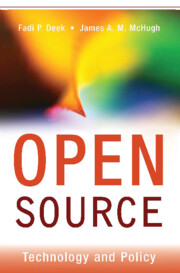Book contents
- Frontmatter
- Contents
- Preface
- Acknowledgments
- 1 Introduction
- Section One Open Source – Internet Applications, Platforms, and Technologies
- 2 Open Source Internet Application Projects
- 3 The Open Source Platform
- 4 Technologies Underlying Open Source Development
- Section Two Social, Psychological, Legal, and Economic Aspects of Open Source
- Section Three Free Software: The Movement, The Public Sector, and the Future
- Glossary
- Subject Index
- Author Index
- References
2 - Open Source Internet Application Projects
Published online by Cambridge University Press: 16 January 2010
- Frontmatter
- Contents
- Preface
- Acknowledgments
- 1 Introduction
- Section One Open Source – Internet Applications, Platforms, and Technologies
- 2 Open Source Internet Application Projects
- 3 The Open Source Platform
- 4 Technologies Underlying Open Source Development
- Section Two Social, Psychological, Legal, and Economic Aspects of Open Source
- Section Three Free Software: The Movement, The Public Sector, and the Future
- Glossary
- Subject Index
- Author Index
- References
Summary
This chapter describes a number of open source applications related to the Internet that are intended to introduce the reader unfamiliar with the world of open development to some of its signature projects, ideas, processes, and people. These projects represent remarkable achievements in the history of technology and business. They brought about a social and communications revolution that transformed society, culture, commerce, technology, and even science. The story of these classic developments as well as those in the next chapter is instructive in many ways: for learning how the open source process works, what some of its major accomplishments have been, who some of the pioneering figures in the field are, how projects have been managed, how people have approached development in this context, what motivations have led people to initiate and participate in such projects, and what some of the business models are that have been used for commercializing associated products.
Web servers and Web browsers are at the heart of the Internet and free software has been prominent on both the server and browser ends. Thus the first open source project we will investigate is a server, the so-called National Center for Supercomputing Applications (NCSA) Web server developed by Rob McCool in the mid-1990s. His work had in turn been motivated by the then recent creation by Tim Berners-Lee of the basic tools and concepts for a World Wide Web (WWW), including the invention of the first Web server and browser, HTML (the Hypertext Markup Language), and the HTTP (Hypertext Transfer Protocol).
- Type
- Chapter
- Information
- Open SourceTechnology and Policy, pp. 21 - 79Publisher: Cambridge University PressPrint publication year: 2007



